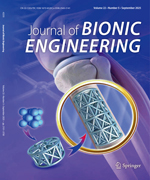In olfactory research, neural oscillations exhibit excellent temporal regularity, which are functional and necessary at the physiological and cognitive levels. In this paper, we employed a bionic tissue biosensor which treats intact epithelium as sensing element to record the olfactory oscillations extracellularly. After being stimulated by odorant of butanedione, the olfactory receptor neurons generated different kinds of oscillations, which can be described as pulse firing oscillation, transient firing oscillation, superposed firing oscillation, and sustained firing oscillation, according to their temporal appearances respectively. With a time-frequency analysis of sonogram, the oscillations also demonstrated different frequency properties, such as δ, θ, α, β and γ oscillations. The results suggest that the bionic biosensor cooperated with sonogram analysis can well improve the investigation of olfactory oscillations, and provide a novel model for artificial olfaction sensor design.

 Table of Content
Table of Content
 Table of Content
Table of Content